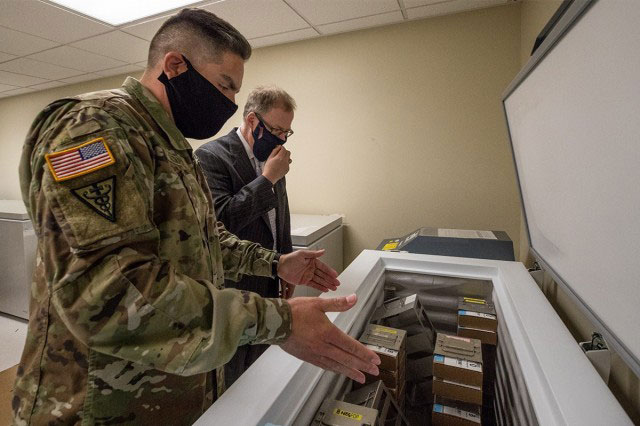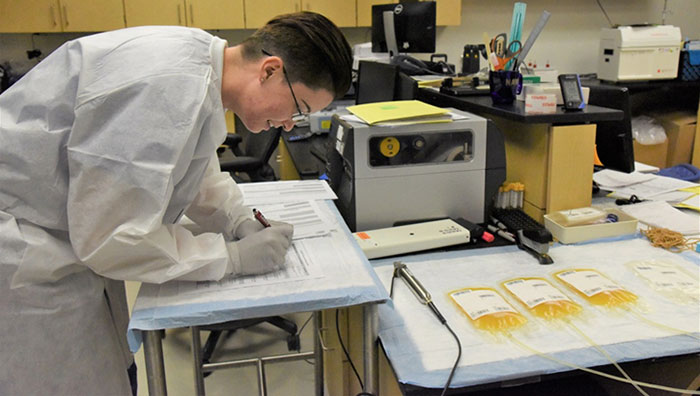USAMMDA's Force Health Protection Division implements COVID-19 treatment protocol across multiple sites

In May, the U.S. Army Medical Materiel Development Activity's Force Health Protection Division received approval from the U.S. Food and Drug Administration to implement an Expanded Access Protocol for "Treatment of Coronavirus Disease 2019 with Anti-Severe Acute Respiratory Syndrome-Coronavirus-2 Convalescent Plasma." COVID-19 Convalescent Plasma, or CCP, is blood plasma taken from patients who have recovered from COVID-19 and have developed antibodies naturally against the illness. The treatment protocol is being utilized in an effort to combat the COVID-19 worldwide pandemic, and all involved are hoping for a positive outcome in a vast majority of patients affected by the disease.
As product management support for the FHP team, Marianne Erlichman serves as liaison between USAMMDA and Army Medical Treatment Facilities, Naval and Air Force hospitals, and Navy ships that hope to become U.S. Army Medical Research and Development Command Institutional Review Board-approved sites for the treatment protocol.
"For the military, COVID-19 poses an increased threat for U.S. troops in certain locations across the globe," said Erlichman. "Currently, there is no licensed vaccine for this disease – only investigational treatments. One of these is COVID-19 Convalescent Plasma, which is a novel intervention."
Erlichman said the first site approved for the protocol was Landstuhl Regional Medical Center, an Army-commanded medical center located near Ramstein Air Base in Germany. LRMC is the evacuation and treatment center for all injured U.S. Service Members and civilians, and numerous coalition forces serving in Iraq and Afghanistan.
Other initially approved protocol sites include Madigan Army Medical Center, Tacoma, Washington; Yokota Air Base Medical Treatment Facility, Japan; U.S. Naval Hospital, Guam; and Evans Army Medical Center, Fort Carson, Colorado, as well as sites in Bagram, Afghanistan, and Baghdad, Iraq.
In mid-July, the Navy's USS Nimitz was the first ship in its fleet to be approved to administer CCP per the treatment protocol. As a supercarrier, Nimitz is the lead ship of her class and one of the largest warships in the world.

Navy Capt. Gilbert Seda, M.D., Ph.D., currently serves Nimitz as lead for the COVID-19 Response Team, and he is the principal investigator for the CCP onboard. Seda is responsible for proper execution of all aspects of the treatment protocol, in accordance with International Conference on Harmonization and Good Clinical Practice guidelines, as well as FDA, Department of Defense and U.S. Army regulations.
"As convalescent plasma has been used successfully to treat other respiratory viruses," said Seda, "this effort is intended to assess whether plasma from people who have recovered from COVID-19 is an effective treatment for people with severe, or risk of severe COVID-19 disease, and whether this treatment causes any unwanted effects."
Seda detailed the process of approving the administration of CCP to patients, in accordance with the treatment protocol. He explained the patient: 1) must have laboratory-confirmed COVID-19 infection; 2) must provide informed consent either directly or through a legally authorized representative; 3) must present with severe or life-threatening COVID-19 illness, or progression to such; and 4) must not have any medical contraindications to receiving CCP.
Seda further explained that CCP can be combined with other treatments for COVID-19 illness, such as corticosteroids, anticoagulants or medications that have FDA emergency use authorization, including remdesivir, which is also available for use on Nimitz. Remdesivir, a broad-spectrum antiviral medication, is available through USAMMDA's FHP Division.
"To be clear, the CCP treatment protocol does not change the Navy's plan to get Sailors with severe COVID-19 illness off of the ship as soon as possible," said Seda.
Since the approval of the Nimitz, additional Navy ships have applied and been approved to serve as medical sites to use CCP in the treatment of COVID-19 patients. These currently include the USS Theodore Roosevelt, USS Abraham Lincoln, USS Ronald Reagan, USS Dwight D. Eisenhower, USS America and USS Gerald R. Ford.
With regard to Army Medicine, a joint-Service collaboration is not unusual, and Seda is well aware of both the benefits and avenues to success in working together towards a common goal.
"I am excited to see the teamwork between the Armed Forces with respect to clinical research and Force Health Protection during this pandemic," he said. "The U.S. Navy Bureau of Medicine and Surgery, and USAMMDA's Force Health Protection Division displayed outstanding joint-service collaboration that significantly contributed to operational readiness and force health protection by rapidly getting CCP on Nimitz."
"It was a pleasure working with Marianne Erlichman from the USAMMDA's FHP Division, and (Navy) Lt. Commander Colleen Cordrick, director of the Navy Blood Program," he added. "Both contributed to the success of the mission. The medical staff members aboard Nimitz were also eager and motivated to participate in the effort, submitting all documents in a timely manner."
Erlichman said 19 sites are currently approved to administer CCP to patients using the treatment protocol, and 12 additional sites are in process for approval. At the time of publication, eight patients across multiple sites were participating in the CCP treatment protocol.
Erlichman detailed the treatment process per the protocol.
"Patients are hospitalized for this protocol usually in an intensive care unit, and they are administered CCP through intravenous infusion," she said. "Patients may receive one or two doses of CCP per the treatment protocol, usually infused over a four-hour period. Then, they are followed through Day 31 of the protocol, or longer if required. Depending on when they are discharged, their Day 31 visit may be conducted via telephone with the treating physician (principal investigator) or someone on their staff."
When asked what the success of this CCP effort means for our nation and our military, Seda responded, "The Secretary of Defense directed the collection and distribution of CCP to protect our military and civilian personnel and their families, safeguard our national security capabilities, and support the President's whole-of-nation response to the pandemic. The desired end state, as it applies to the U.S. Navy, is the development of CCP storage and administration as a therapeutic for severe COVID-19 infection aboard all Role (of Care)-2 and -3 ships."
"Aircraft carriers serve a significant role in humanitarian assistance, deterrence, sea control and maritime security operations throughout the world," he continued. "Having CCP on Nimitz makes the ship more mission-capable by adding a potential therapeutic for force protection in the event of a severe COVID-19 infection."
Army Col. Gina E. Adam, USAMMDA commander, has been closely following the progression of the CCP treatment protocol, as well as the ongoing addition of new sites, and she remains confident in the FHP team's ability to safely deploy experimental treatments wherever needed by our nation's Service Members.
"The FHP team has built a network of joint medical facilities globally that are participating in this treatment protocol," said Adam. "The inclusion of Navy ships afloat is unprecedented and indicative of the lengths to which this team will go to ensure treatment options are available where needed."
Erlichman said the FHP team expects additional facilities, beyond those currently in process, will be approved as CCP protocol sites in the upcoming months.
USAMMDA is a subordinate command of the U.S. Army Medical Research and Development Command, under the Army Futures Command. As the premier developer of world-class military medical capabilities, USAMMDA is responsible for developing and delivering critical products designed to protect and preserve the lives of Warfighters across the globe. These products include drugs, vaccines, biologics, devices and medical support equipment intended to maximize survival of casualties on the battlefield.













